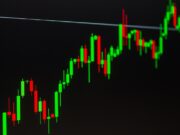As global markets digest a sweeping new round of tariffs announced by the U.S. administration, investors are left wondering: is this the start of a full-blown trade war, or a high-stakes negotiation tactic?
Markets didn’t wait for the answer. The S&P 500 dropped 4% following the announcement — a sharp move that underscores just how sensitive the market remains to geopolitical uncertainty. It’s now pacing for its worst single-day performance in more than two years.
The reality is this: while the U.S. has long faced asymmetric trade terms, with persistent deficits and structural disadvantages, shifting global supply chains takes time. Many expected policymakers to give businesses some runway to adjust. That didn’t happen.
Instead, a more aggressive, immediate stance was unveiled, and now the market is bracing for potential retaliation. This kind of uncertainty — combined with higher import costs and inflation risk — has led several firms to raise recession odds. Federal Reserve Chair Jerome Powell recently acknowledged the inflationary risk from tariffs, though he emphasized it could be a one-time adjustment if escalation is avoided.
What’s Different This Time?
Traders often follow the “sell the news” playbook: options premiums rise into major events and fall afterward as volatility is priced out. But this time, the scale of the tariffs and the potential for drawn-out retaliatory measures has options markets behaving differently.
This isn’t a one-off data point or earnings print — it’s an evolving geopolitical story. And if past episodes are any guide, prolonged trade battles can have serious economic consequences. The Smoot-Hawley tariffs of the 1930s are often cited as having deepened the Great Depression. While today’s situation is different, the risks of escalation are real.
The concern now is twofold: if trading partners push back, tensions could drag on, keeping volatility — and options premiums — elevated. If they fold, markets could quickly stabilize. But that outcome may be politically difficult for leaders abroad, especially if appearing conciliatory risks backlash at home.
Why Hedging Makes Sense
We’ve seen markets fall 20% or more in relatively short windows — from the Fed-driven drawdown in 2022 to the Q4 2018 slide during the last round of tightening. The current setup carries similar headline risk. Elevated valuations, policy uncertainty, and slowing growth abroad make for a fragile backdrop.
Given the potential for sharp downside and ongoing volatility, hedging exposure — particularly in broad market indices — may be a wise move here.
The Hedge: Put Spread on SPY
One efficient way to protect against further downside is with a put spread on the SPDR S&P 500 ETF (SPY). This strategy helps cap costs while offering meaningful protection in the event of a deeper correction.
Here’s a sample trade:
- Buy SPY May 30 $550 put
- Sell SPY May 30 $500 put
As of the most recent close, this spread was priced near $6.00. That’s roughly 12% of the $50 spread width — a manageable cost for “disaster protection” should trade tensions spiral or economic data worsen.
The idea isn’t to bet on catastrophe, but to acknowledge that the environment has changed — and that the path forward isn’t as predictable as markets might hope.





